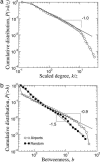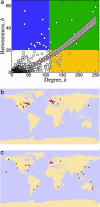The worldwide air transportation network: Anomalous centrality, community structure, and cities' global roles
- PMID: 15911778
- PMCID: PMC1142352
- DOI: 10.1073/pnas.0407994102
The worldwide air transportation network: Anomalous centrality, community structure, and cities' global roles
Abstract
We analyze the global structure of the worldwide air transportation network, a critical infrastructure with an enormous impact on local, national, and international economies. We find that the worldwide air transportation network is a scale-free small-world network. In contrast to the prediction of scale-free network models, however, we find that the most connected cities are not necessarily the most central, resulting in anomalous values of the centrality. We demonstrate that these anomalies arise because of the multicommunity structure of the network. We identify the communities in the air transportation network and show that the community structure cannot be explained solely based on geographical constraints and that geopolitical considerations have to be taken into account. We identify each city's global role based on its pattern of intercommunity and intracommunity connections, which enables us to obtain scale-specific representations of the network.
Figures




References
-
- Bisseur, A. & Alamdari, F. (1998) Transportation 25, 331–355.
-
- Dana, L. P. & Vignali, D. (1999) Int. Marketing Rev. 16, 278–290.
-
- Turton, B. J. & Mutambirwa, C. C. (1996) Tourism Manage. 17, 453–462.
-
- Raguraman, K. (1998) Tourism Manage. 19, 533–543.
-
- Liljeros, F., Edling, C. R., Amaral, L. A. N., Stanley, H. E. & Aberg, Y. (2001) Nature 411, 907–908. - PubMed
Grants and funding
LinkOut - more resources
Full Text Sources

